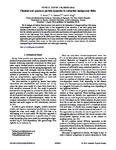Classical and quantum particle dynamics in univariate background fields
| dc.contributor.author | Heinzl, Thomas | |
| dc.contributor.author | Ilderton, A | |
| dc.contributor.author | King, B | |
| dc.date.accessioned | 2016-10-26T17:46:13Z | |
| dc.date.available | 2016-10-26T17:46:13Z | |
| dc.date.issued | 2016 | |
| dc.identifier.issn | 2470-0010 | |
| dc.identifier.issn | 2470-0029 | |
| dc.identifier.other | 6 | |
| dc.identifier.uri | http://hdl.handle.net/10026.1/6635 | |
| dc.description | 12 pages, 8 figures | |
| dc.description.abstract |
We investigate deviations from the plane wave model in the interaction of charged particles with strong electromagnetic fields. A general result is that integrability of the dynamics is lost when going from lightlike to timelike or spacelike field dependence. For a special scenario in the classical regime we show how the radiation spectrum in the spacelike (undulator) case becomes well-approximated by the plane wave model in the high-energy limit, despite the two systems being Lorentz inequivalent. In the quantum problem, there is no analogue of the WKB-exact Volkov solution. Nevertheless, WKB and uniform-WKB approaches give good approximations in all cases considered. Other approaches that reduce the underlying differential equations from second to first order are found to miss the correct physics for situations corresponding to barrier transmission and wide-angle scattering. | |
| dc.format.extent | 065039-065039 | |
| dc.language | en | |
| dc.language.iso | en | |
| dc.publisher | American Physical Society | |
| dc.subject | hep-th | |
| dc.subject | hep-th | |
| dc.title | Classical and quantum particle dynamics in univariate background fields | |
| dc.type | journal-article | |
| dc.type | article | |
| plymouth.author-url | https://www.webofscience.com/api/gateway?GWVersion=2&SrcApp=PARTNER_APP&SrcAuth=LinksAMR&KeyUT=WOS:000384077100007&DestLinkType=FullRecord&DestApp=ALL_WOS&UsrCustomerID=11bb513d99f797142bcfeffcc58ea008 | |
| plymouth.issue | 6 | |
| plymouth.volume | 94 | |
| plymouth.publisher-url | http://dx.doi.org/10.1103/PhysRevD.94.065039 | |
| plymouth.publication-status | Published online | |
| plymouth.journal | Physical Review D | |
| dc.identifier.doi | 10.1103/physrevd.94.065039 | |
| plymouth.organisational-group | /Plymouth | |
| plymouth.organisational-group | /Plymouth/Faculty of Science and Engineering | |
| plymouth.organisational-group | /Plymouth/Faculty of Science and Engineering/School of Engineering, Computing and Mathematics | |
| plymouth.organisational-group | /Plymouth/REF 2021 Researchers by UoA | |
| plymouth.organisational-group | /Plymouth/REF 2021 Researchers by UoA/EXTENDED UoA 10 - Mathematical Sciences | |
| plymouth.organisational-group | /Plymouth/REF 2021 Researchers by UoA/UoA10 Mathematical Sciences | |
| plymouth.organisational-group | /Plymouth/Users by role | |
| plymouth.organisational-group | /Plymouth/Users by role/Academics | |
| plymouth.organisational-group | /Plymouth/Users by role/Researchers in ResearchFish submission | |
| dc.identifier.eissn | 2470-0029 | |
| dc.rights.embargoperiod | Not known | |
| rioxxterms.versionofrecord | 10.1103/physrevd.94.065039 | |
| rioxxterms.licenseref.uri | http://www.rioxx.net/licenses/all-rights-reserved | |
| rioxxterms.type | Journal Article/Review | |
| plymouth.oa-location | http://arxiv.org/abs/arXiv:1607.07449 |


